Effect of Fibres on the Failure Mechanism of Composite Tubes under Low-Velocity Impact
Abstract
:1. Introduction
2. Materials and Methods
2.1. Materials
2.2. Fabrication of Composite Tubes by Wet-Filament Winding
2.3. Low-Velocity Impact Tests
2.4. Damage Characterization
2.5. Radial Residual Compression Strength Test
2.6. Scanning Electron Microscopy (SEM) Characterization
3. Results and Discussion
3.1. Low-Velocity Impact Response
3.2. Low-Velocity Impact Damage Characterisation
3.3. Radial Compression after Impact Response and Behaviour
4. Conclusions
- Delamination and fibre breakage damage are the main failure mechanisms of FRP tubes when subjected to LVI. The damage degree depends on the interfacial adhesion between the fibres and resins, and the mechanical properties of the tubes. Global fibre breakage damage occurs in the CFRP-T800 and CFRP-T700 tubes, while localized fibre breakage occurs in the BFRP and GFRP tubes.
- The residual deformation ratios of the composite tubes show the following trend: GFRP tube > CFRP tubes > BFRP tube—the same as the percentages of energy absorption. The residual deformation ratio and the energy absorption percentage of CFRP-T700 and CFRP-T800 tubes differ little, which related to their mechanical properties. The GFRP tube absorbs the most energy through delamination and large deformation, which shows the best impact resistance. The BFRP tube absorbs the lowest energy, mainly by delamination, which shows the poorest impact resistance.
- LVI has a considerable influence on the R-RCS of composite tubes. The retention rates of R-RSC of the four tubes are 88.1%, 90.7%, 97.3%, and 73.8%. The BFRP tube is not sensitive to impact, and the GFRP tube is highly sensitive to impact.
Author Contributions
Funding
Conflicts of Interest
References
- Huang, Y.D.; Liu, L.; Qiu, J.; Shao, L. Influence of ultrasonic treatment on the characteristics of epoxy resin and the interfacial property of its carbon fiber composites. Compos. Sci. Technol. 2002, 62, 2153–2159. [Google Scholar] [CrossRef]
- Zhao, J.; Liu, L.; Guo, Q.; Shi, J.; Zhai, G.; Song, J.; Liu, Z. Growth of carbon nanotubes on the surface of carbon fibers. Carbon 2008, 46, 380–383. [Google Scholar] [CrossRef]
- Geim, A.K.; Novoselov, K.S. The rise of graphene. Nat. Mater. 2007, 6, 183–191. [Google Scholar] [CrossRef] [PubMed]
- Huang, Z.-M.; Zhang, Y.; Kotaki, M.; Ramakrishna, S. A review on polymer nanofibers by electrospinning and their applications in nanocomposites. Compos. Sci. Technol. 2003, 63, 2223–2253. [Google Scholar] [CrossRef]
- Sapuan, S.M. A knowledge-based system for materials selection in mechanical engineering design. Mater. Des. 2001, 22, 687–695. [Google Scholar] [CrossRef]
- Hesse, S.; Lukaszewicz, D.-J.; Duddeck, F. A method to reduce design complexity of automotive composite structures with respect to crashworthiness. Compos. Struct. 2015, 129, 236–249. [Google Scholar] [CrossRef]
- Liu, Y.; Zhuang, W.; Wu, D. Performance and damage of carbon fibre reinforced polymer tubes under low-velocity transverse impact. Thin-Walled Struct. 2020, 151, 106727. [Google Scholar] [CrossRef]
- Davies, G.A.O.; Olsson, R. Impact on composite structures. Aeronaut. J. 2004, 108, 541–563. [Google Scholar] [CrossRef]
- Berton, T.; Najafi, F.; Singh, C.V. Development and implementation of a multi-scale model for matrix micro-cracking prediction in composite structures subjected to low velocity impact. Compos. Part B Eng. 2019, 168, 140–151. [Google Scholar] [CrossRef]
- Minak, G.; Abrate, S.; Ghelli, D.; Panciroli, R.; Zucchelli, A. Low-velocity impact on carbon/epoxy tubes subjected to torque—Experimental results, analytical models and FEM analysis. Compos. Struct. 2010, 92, 623–632. [Google Scholar] [CrossRef]
- Wang, S.-X.; Wu, L.-Z.; Ma, L. Low-velocity impact and residual tensile strength analysis to carbon fiber composite laminates. Mater. Des. 2010, 31, 118–125. [Google Scholar] [CrossRef]
- Sarasini, F.; Tirillò, J.; Valente, M.; Ferrante, L.; Cioffi, S.; Iannace, S.; Sorrentino, L. Hybrid composites based on aramid and basalt woven fabrics: Impact damage modes and residual flexural properties. Mater. Des. 2013, 49, 290–302. [Google Scholar] [CrossRef]
- Debski, H.; Rozylo, P.; Gliszczyński, A. Effect of low-velocity impact damage location on the stability and postcritical state of composite columns under compression. Compos. Struct. 2018, 184, 883–893. [Google Scholar] [CrossRef]
- Rozylo, P.; Debski, H.; Kubiak, T. A model of low-velocity impact damage of composite plates subjected to Compression-After-Impact (CAI) testing. Compos. Struct. 2017, 181, 158–170. [Google Scholar] [CrossRef]
- Gning, P.-B.; Tarfaoui, M.; Collombet, F.; Riou, L.; Davies, P. Damage development in thick composite tubes under impact loading and influence on implosion pressure: Experimental observations. Compos. Part B Eng. 2005, 36, 306–318. [Google Scholar] [CrossRef]
- Silberschmidt, V.V. Dynamic Deformation, Damage and Fracture in Composite Materials and Structures; Woodhead Publishing series in composites science and engineering; Woodhead Publishing: Duxford, UK, 2016; Volume xvi, 600p. [Google Scholar]
- Kara, M.; Kırıcı, M.; Tatar, A.C.; Avcı, A.; Kirici, M.; Avcı, A. Impact behavior of carbon fiber/epoxy composite tubes reinforced with multi-walled carbon nanotubes at cryogenic environment. Compos. Part B Eng. 2018, 145, 145–154. [Google Scholar] [CrossRef]
- Kim, H.S.; Kim, B.C.; Lim, T.S.; Gil Lee, D. Foreign objects impact damage characteristics of aluminum/composite hybrid drive shaft. Compos. Struct. 2004, 66, 377–389. [Google Scholar] [CrossRef]
- Wu, Z.; Shi, L.; Wu, Z.; Xiang, Z.; Hu, X. Transverse impact behavior and residual axial compression characteristics of braided composite tubes: Experimental and numerical study. Int. J. Impact Eng. 2020, 142, 103578. [Google Scholar] [CrossRef]
- Alam, I.; Fawzia, S. Numerical studies on CFRP strengthened steel columns under transverse impact. Compos. Struct. 2015, 120, 428–441. [Google Scholar] [CrossRef] [Green Version]
- Mokhtar, I.; Yahya, M.Y.; Kader, A.S.A.; Abu Hassan, S.; Santulli, C. Transverse impact response of filament wound basalt composite tubes. Compos. Part B Eng. 2017, 128, 134–145. [Google Scholar] [CrossRef]
- Hassan, M.; Naderi, S.; Bushroa, A. Low-velocity impact damage of woven fabric composites: Finite element simulation and experimental verification. Mater. Des. 2014, 53, 706–718. [Google Scholar] [CrossRef]
- Quispitupa, A.; Shafiq, B.; Just, F.; Serrano, D. Acoustic emission based tensile characteristics of sandwich composites. Compos. Part B Eng. 2004, 35, 563–571. [Google Scholar] [CrossRef]
- Yan, R.; Wang, R.; Lou, C.-W.; Huang, S.-Y.; Lin, J.-H. Quasi-static and dynamic mechanical responses of hybrid laminated composites based on high-density flexible polyurethane foam. Compos. Part B Eng. 2015, 83, 253–263. [Google Scholar] [CrossRef]
- Chen, N.; Luo, Q.; Meng, M.; Li, Q.; Sun, G. Low velocity impact behavior of interlayer hybrid composite laminates with carbon/glass/basalt fibres. Compos. Part B Eng. 2019, 176, 107191. [Google Scholar] [CrossRef]
- Giannopoulos, I.; Theotokoglou, E.E.; Zhang, X. Impact damage and CAI strength of a woven CFRP material with fire retardant properties. Compos. Part B Eng. 2016, 91, 8–17. [Google Scholar] [CrossRef] [Green Version]
- Leijten, J.; Bersee, H.E.; Bergsma, O.K.; Beukers, A. Experimental study of the lowvelocity impact behaviour of primary sandwich structures in aircraft. Compos. Part A Appl. Sci. Manuf. 2009, 40, 164–175. [Google Scholar] [CrossRef]
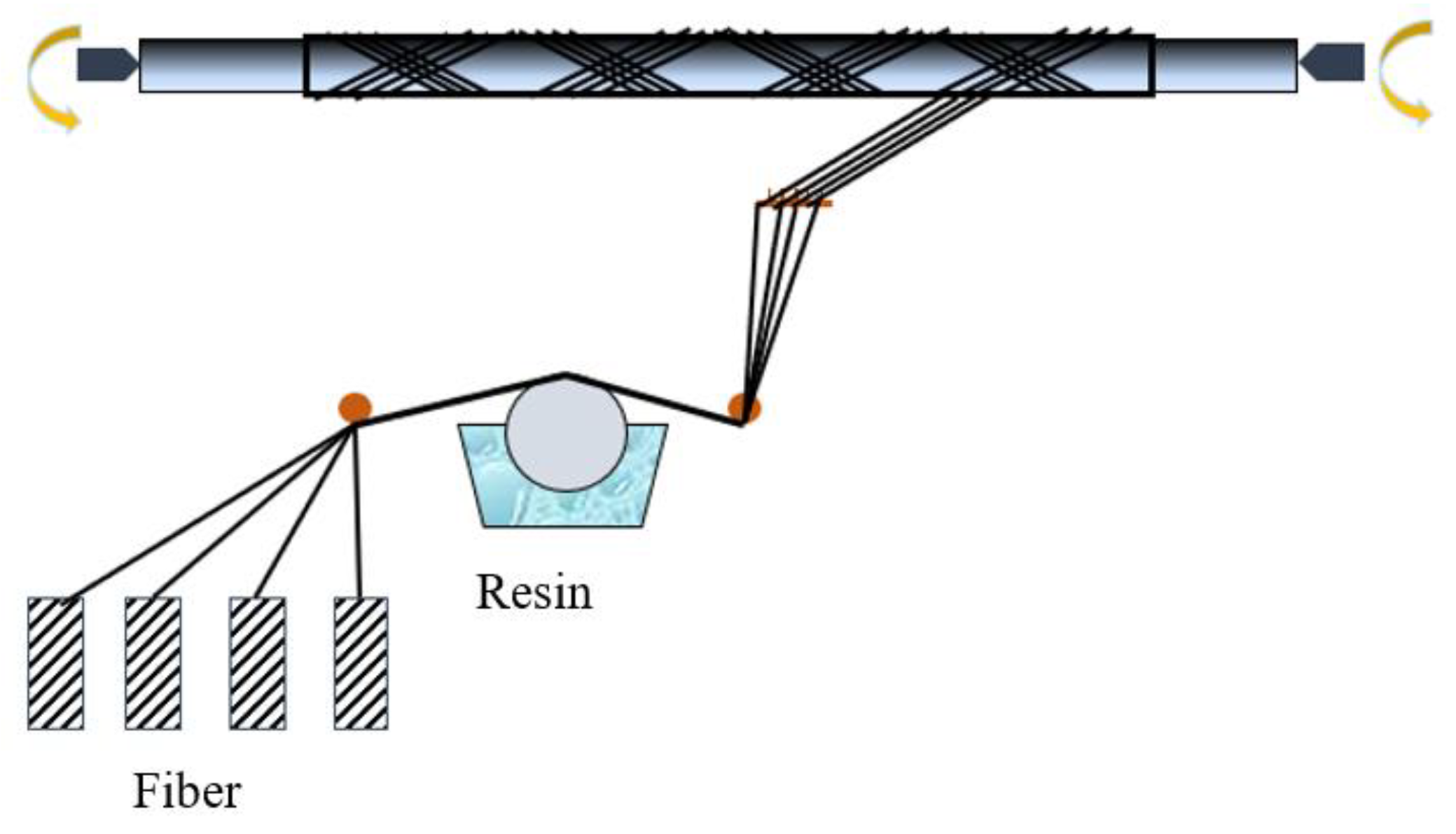
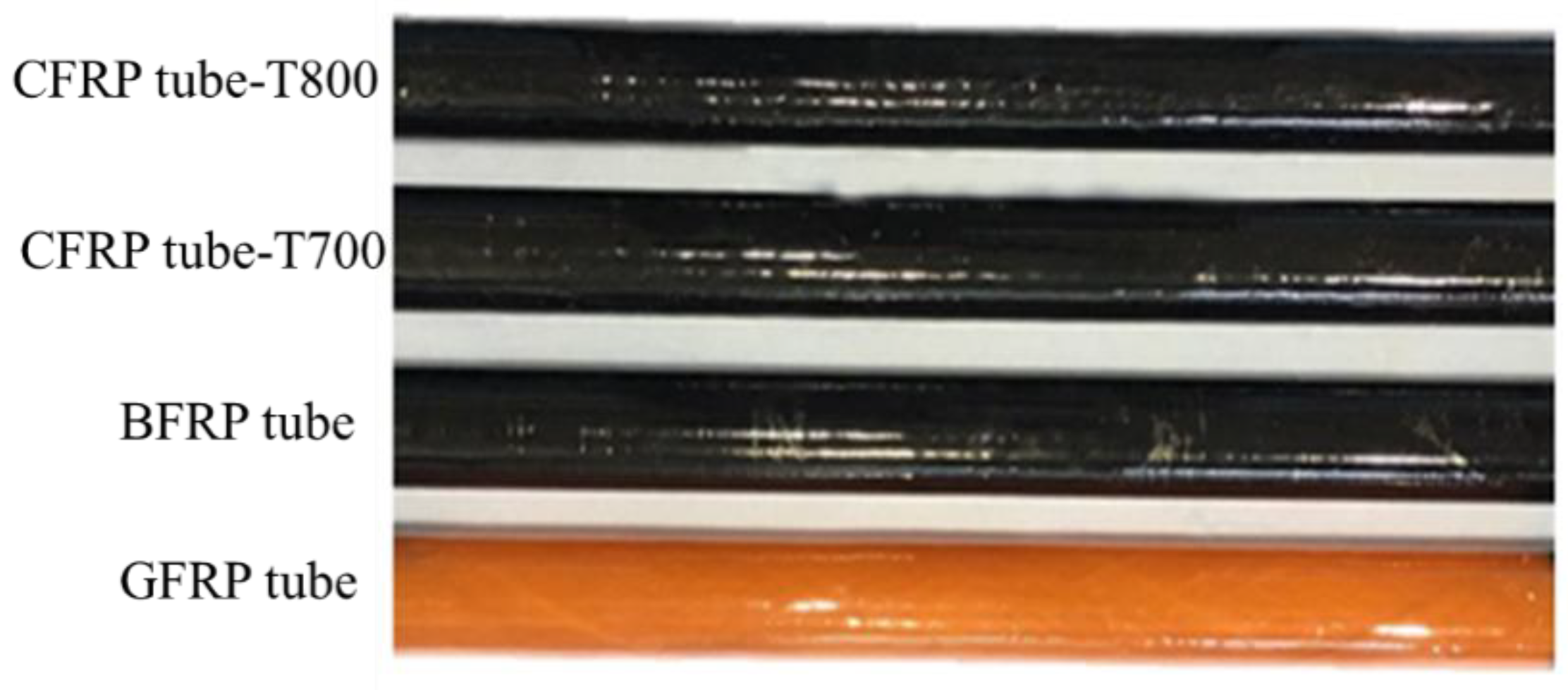
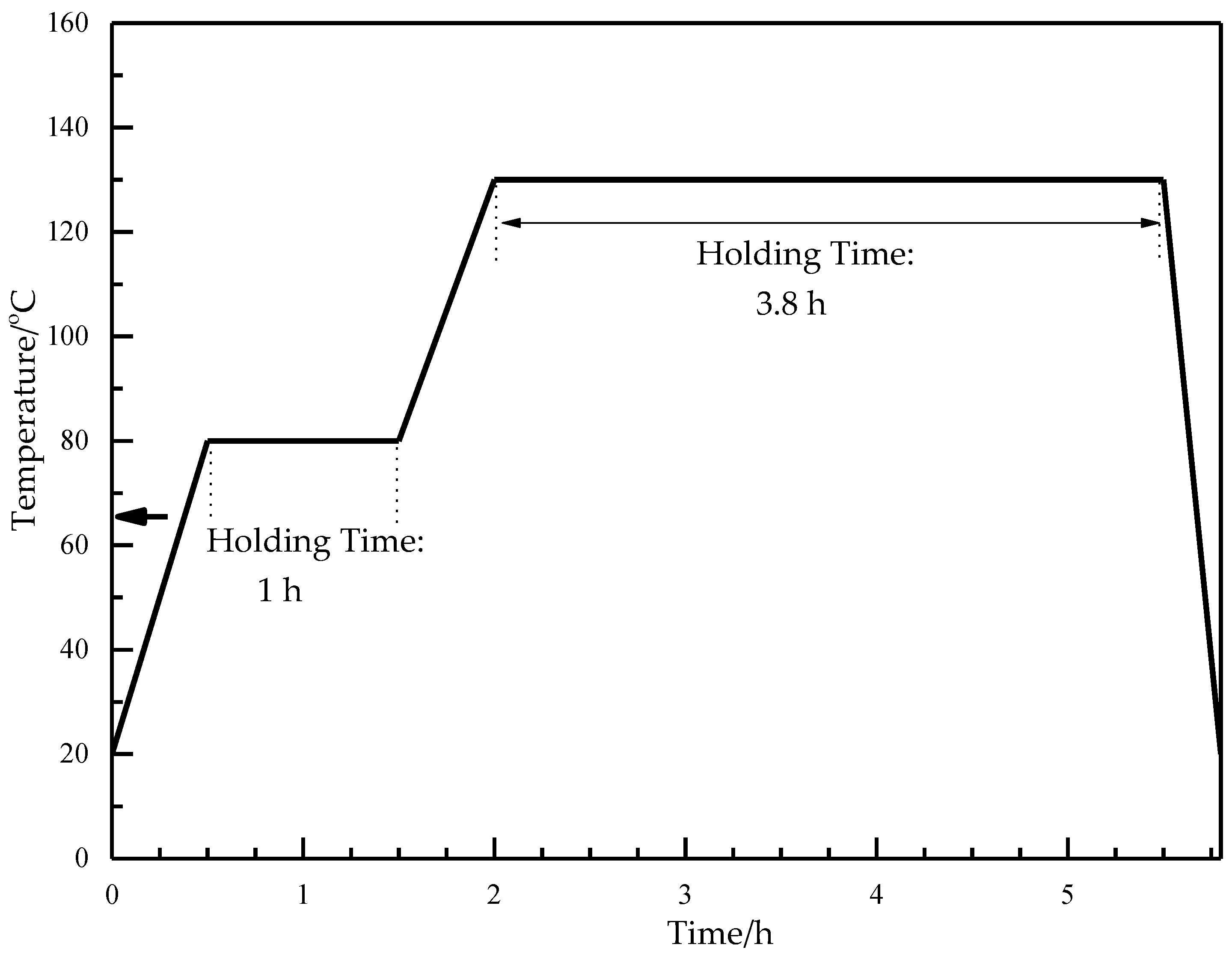

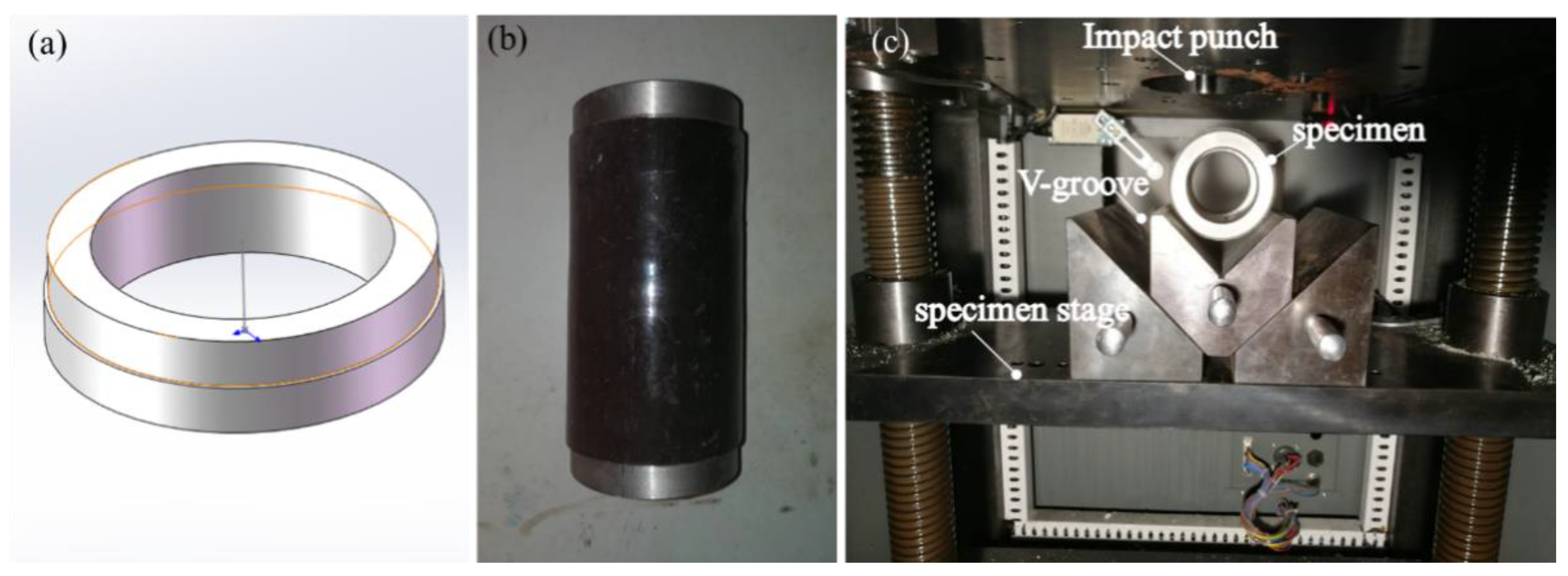
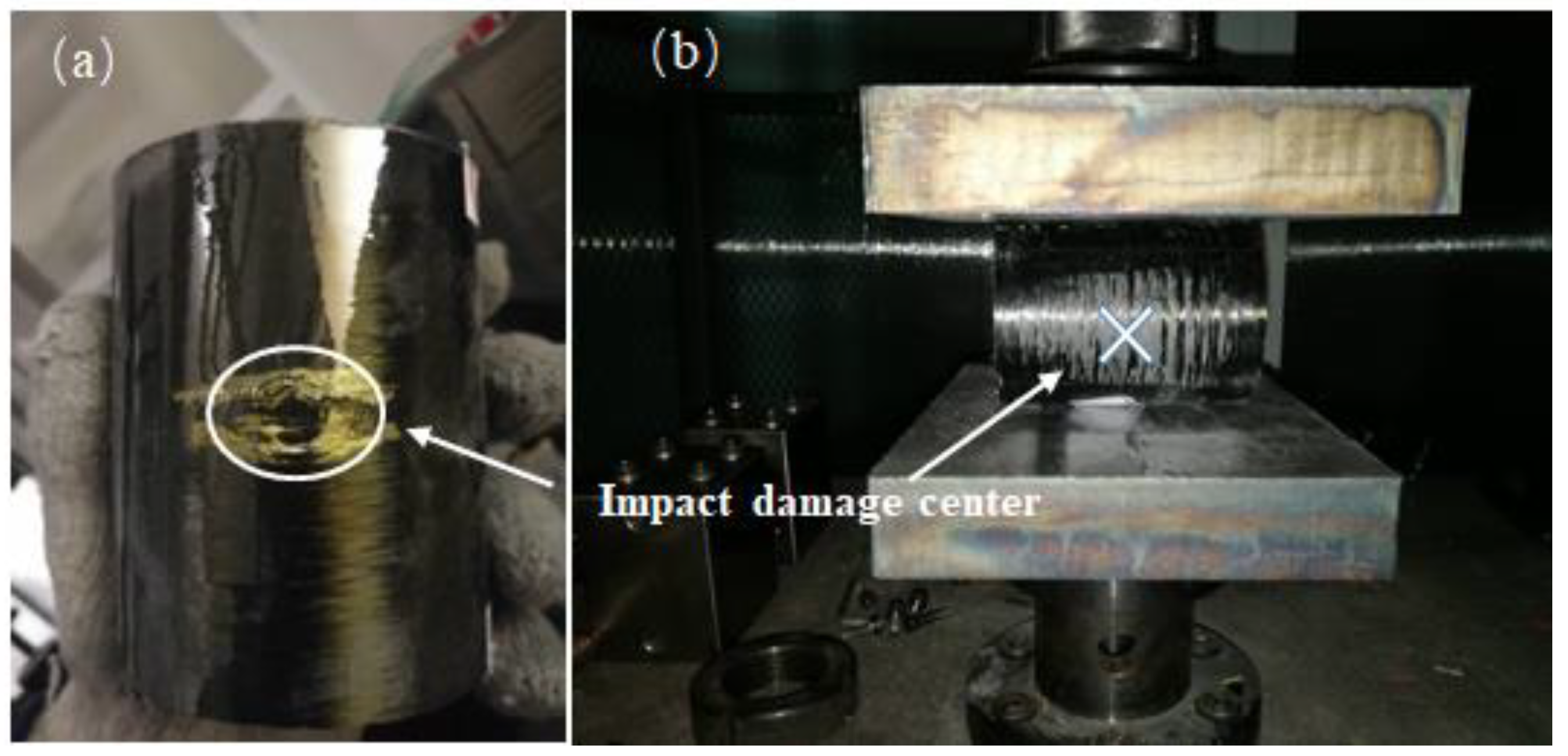

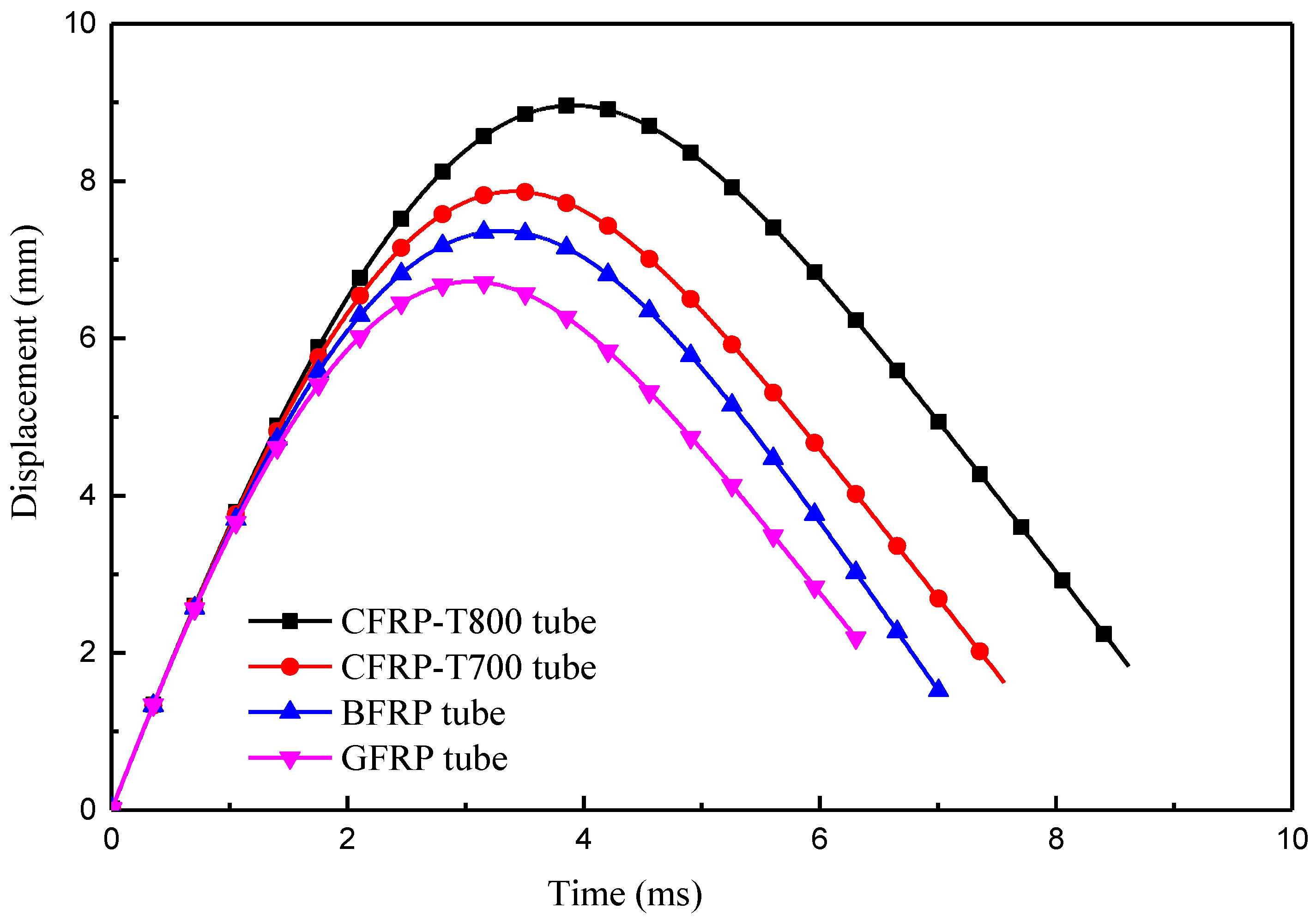
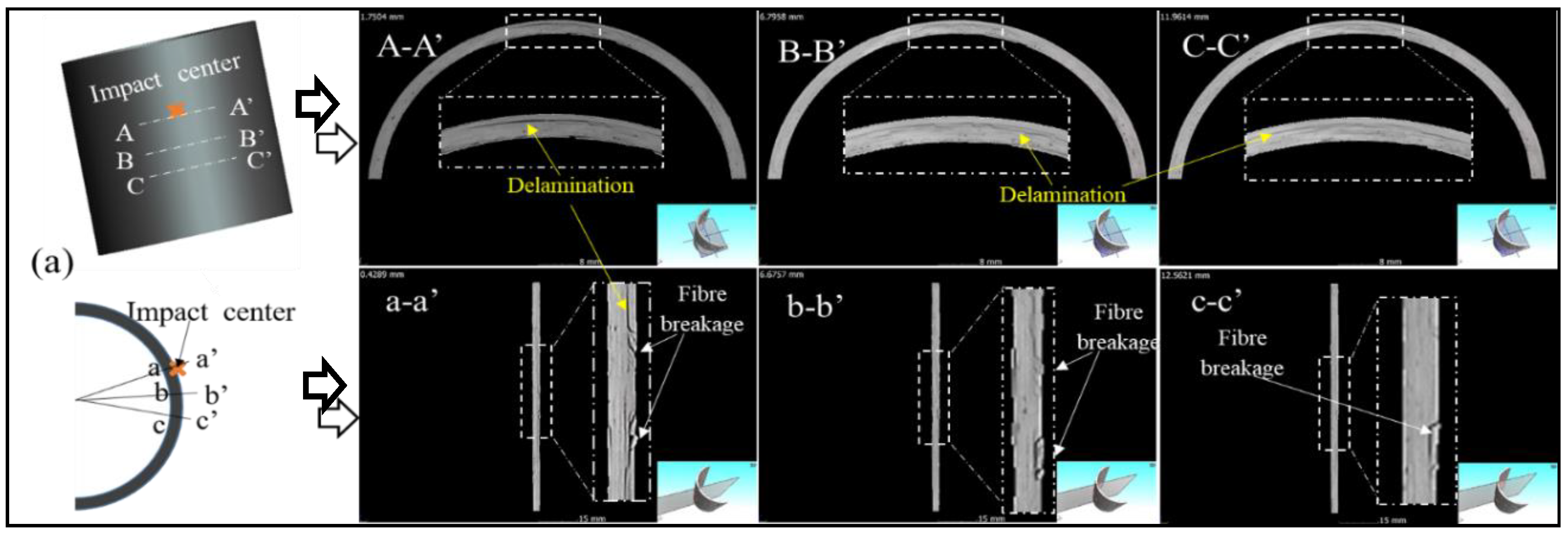
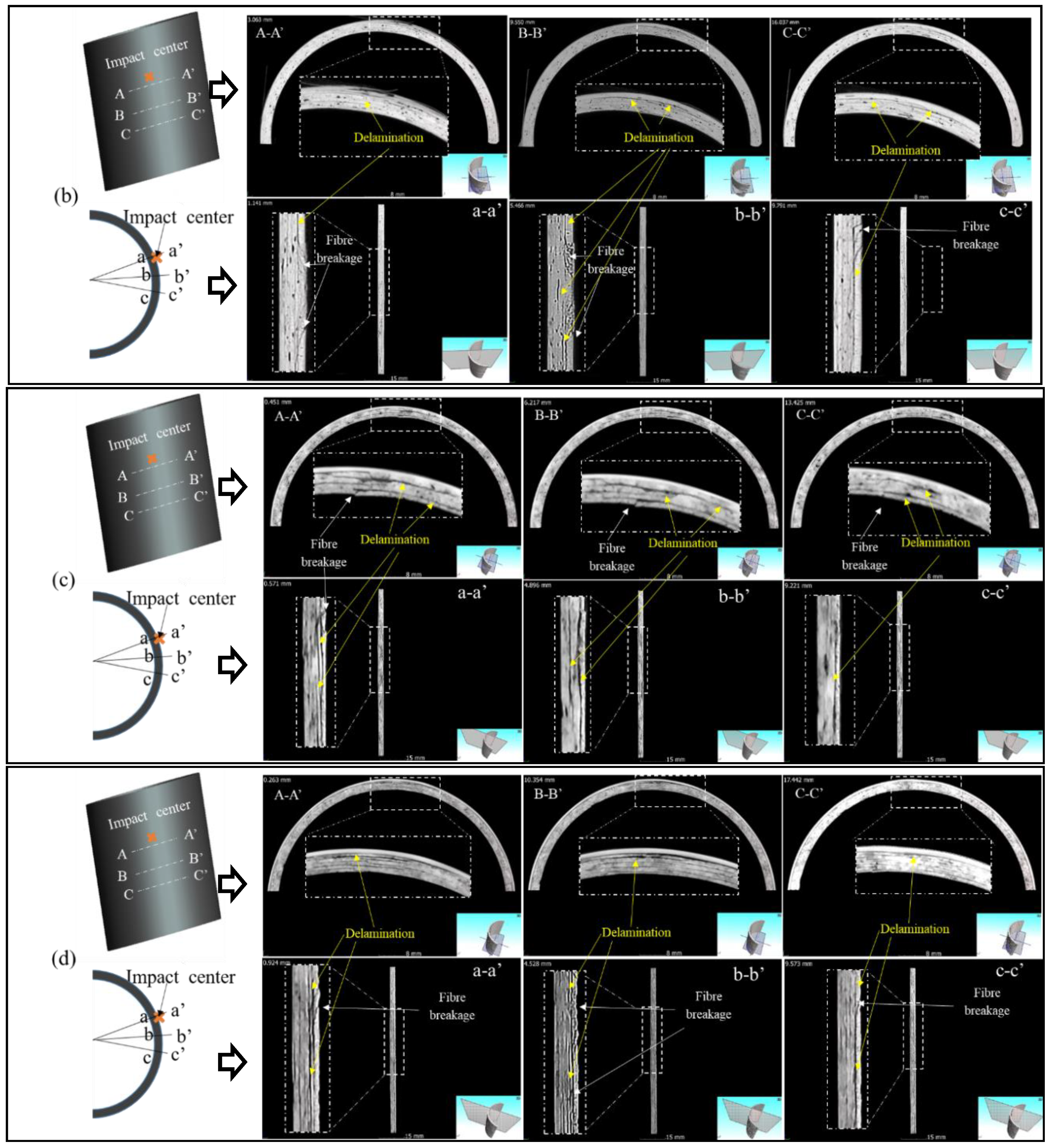

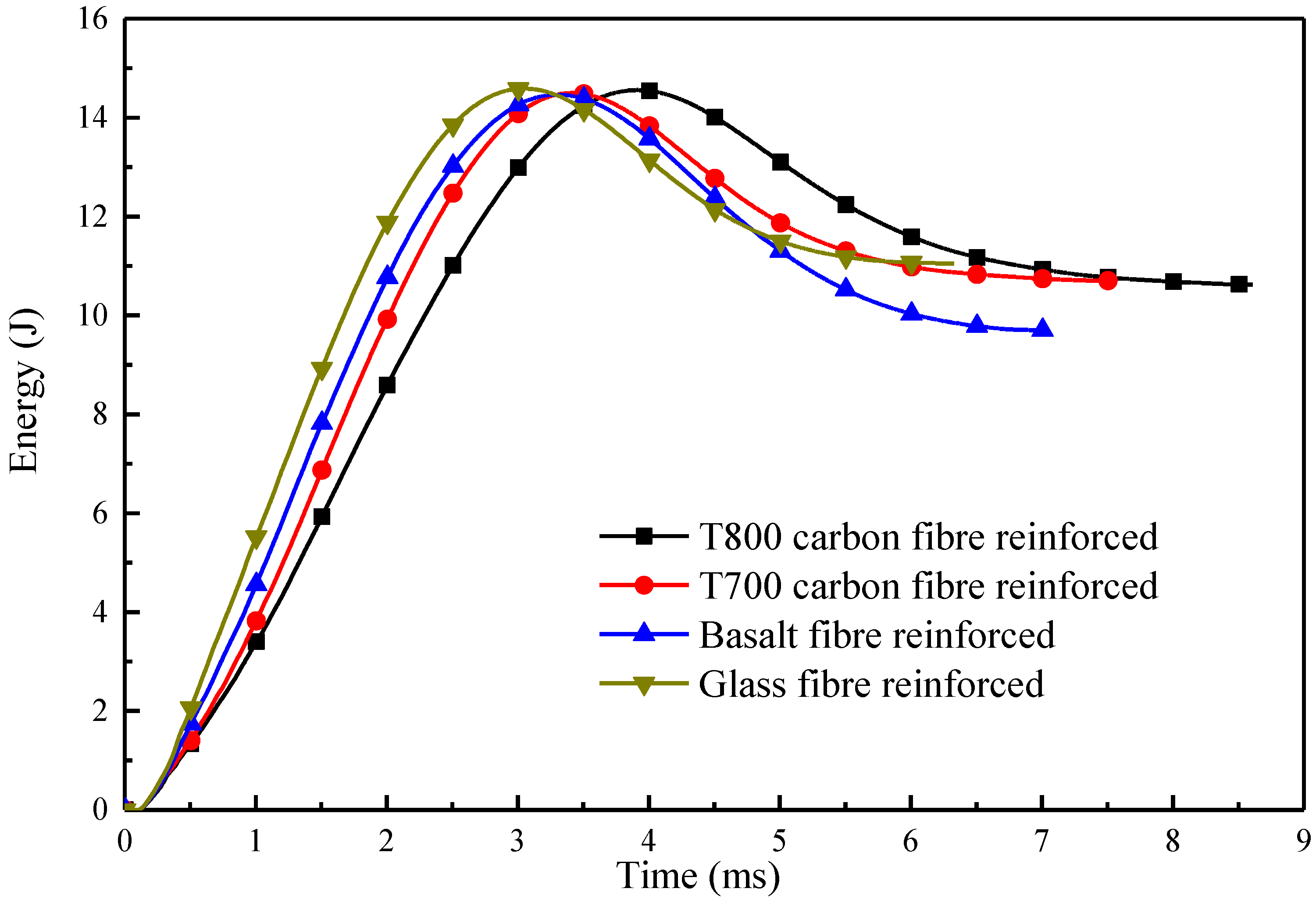
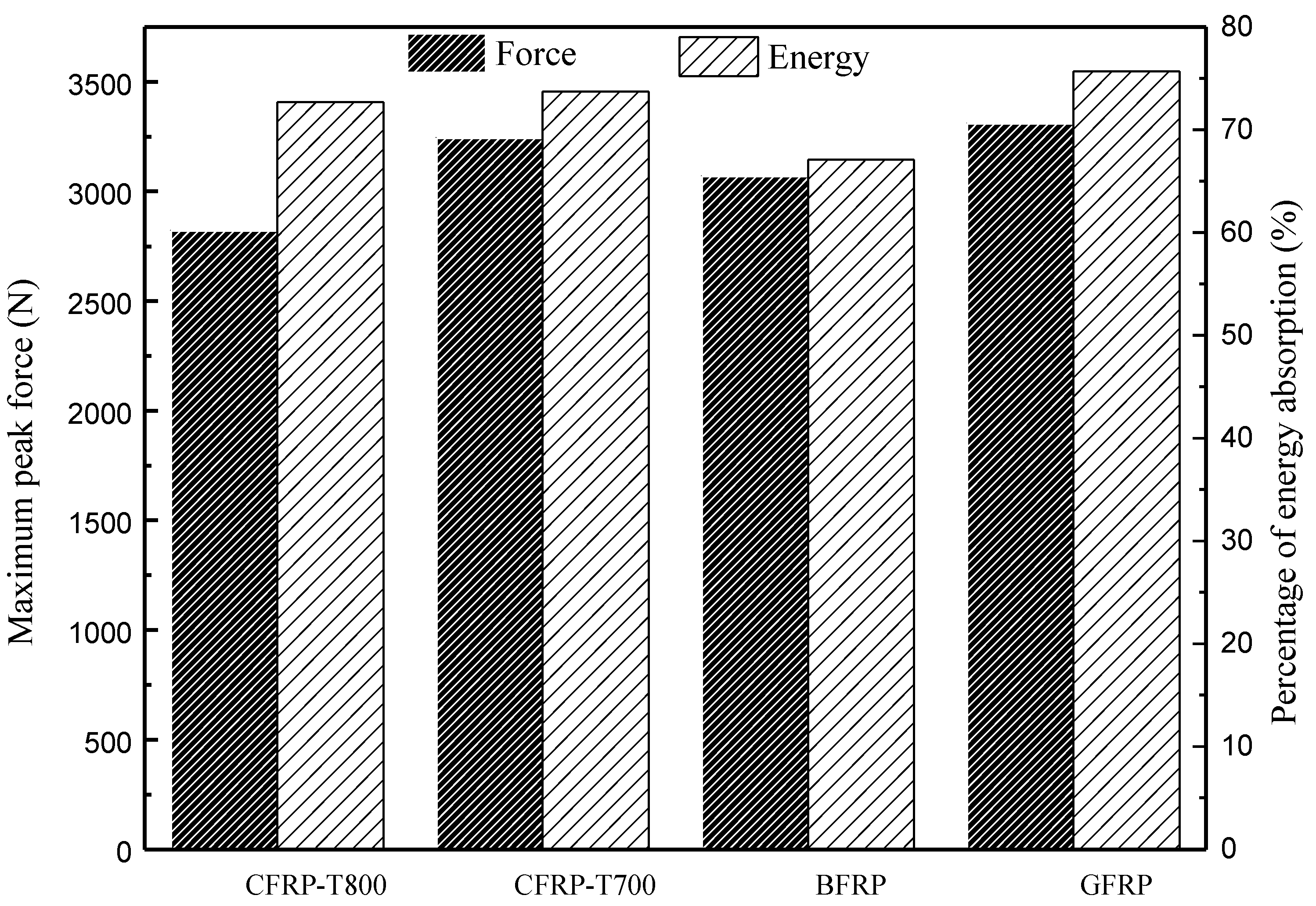

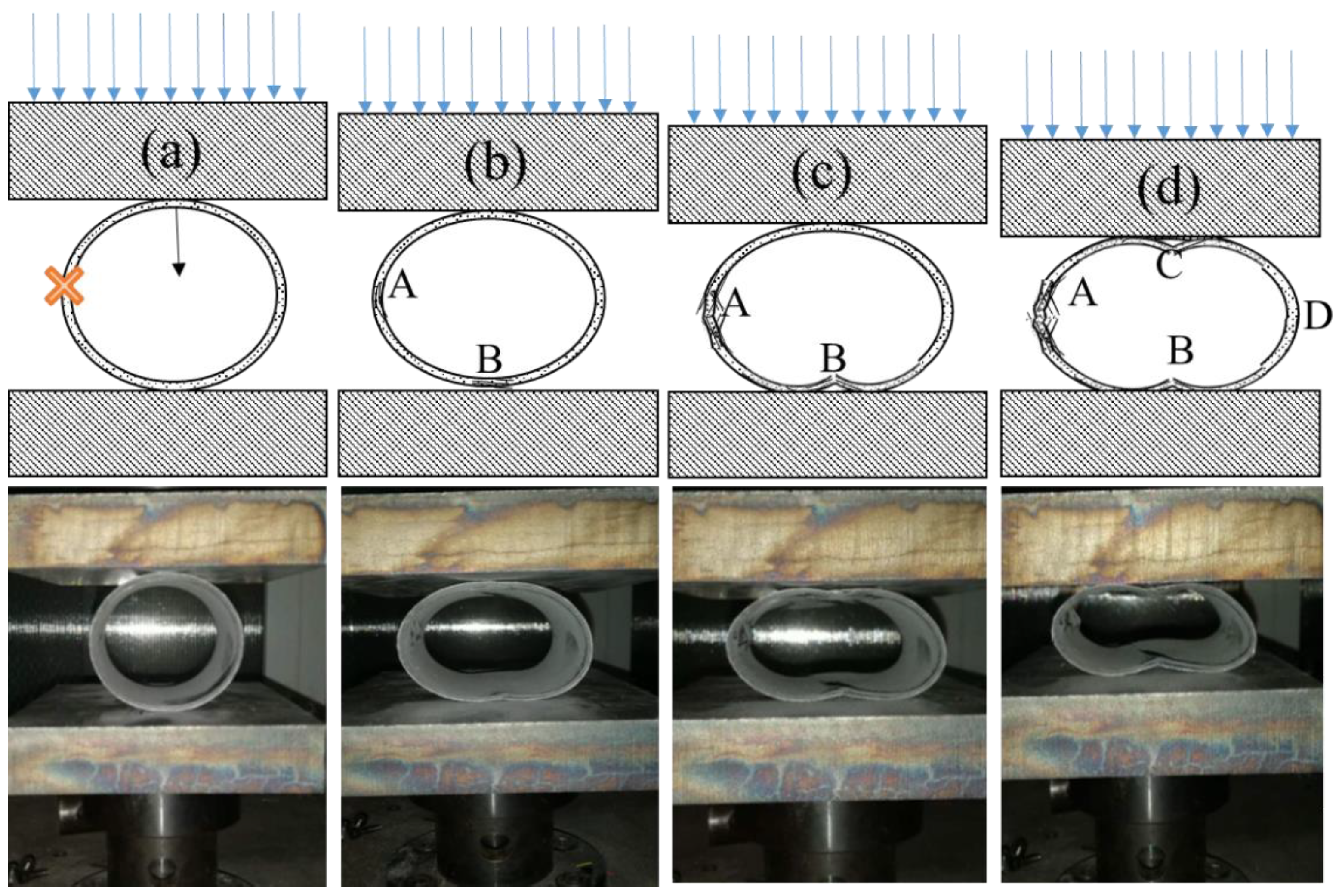
| Types | Tensile Strength (MPa) | Tensile Modulus (GPa) | Elongation at Break (%) |
|---|---|---|---|
| Carbon fibre-T800 | 5880 | 294 | 1.9 |
| Carbon fibre-T700 | 4900 | 230 | 2.1 |
| Basalt fibre | 3500 | 100 | 3.2 |
| Glass fibre | 2800 | 86 | 4.8 |
| Materials | Tensile Strength/MPa | Tensile Modulus/GPa | Poisson’s Ratio | Shear Strength/MPa | Density/g·cm3 |
|---|---|---|---|---|---|
| CFRP-T800 | 1336.1 (1) | 137.9 (1) | 0.26 (12) | 56.4 (12) | 1.43 |
| CFRP-T700 | 1263.2 (1) | 128.7 (1) | 0.27 (12) | 57.01 (12) | 1.61 |
| BFRP | 648.3 (1) | 50.2 (1) | 0.30 (12) | 55.64 (12) | 1.93 |
| GFRP | 793.2 (1) | 43.7 (1) | 0.28 (12) | 57.30 (12) | 1.90 |
| Types | Failure Mechanism | Residual Deformation Ratio (%) | r (Percentage of Energy Absorption, %) |
|---|---|---|---|
| CFRP-T800 | Global fibre breakage and delamination damage | 20.4 | 72.7 |
| CFRP-T700 | Global fibre breakage and delamination damage | 20.5 | 73.7 |
| BFRP | Localized fibre breakage and delamination damage | 20.0 | 67.1 |
| GFRP | Localized fibre breakage and delamination damage | 32.0 | 75.7 |
© 2020 by the authors. Licensee MDPI, Basel, Switzerland. This article is an open access article distributed under the terms and conditions of the Creative Commons Attribution (CC BY) license (http://creativecommons.org/licenses/by/4.0/).
Share and Cite
Xiao, J.; Shi, H.; Tao, L.; Qi, L.; Min, W.; Zhang, H.; Yu, M.; Sun, Z. Effect of Fibres on the Failure Mechanism of Composite Tubes under Low-Velocity Impact. Materials 2020, 13, 4143. https://doi.org/10.3390/ma13184143
Xiao J, Shi H, Tao L, Qi L, Min W, Zhang H, Yu M, Sun Z. Effect of Fibres on the Failure Mechanism of Composite Tubes under Low-Velocity Impact. Materials. 2020; 13(18):4143. https://doi.org/10.3390/ma13184143
Chicago/Turabian StyleXiao, Jie, Han Shi, Lei Tao, Liangliang Qi, Wei Min, Hui Zhang, Muhuo Yu, and Zeyu Sun. 2020. "Effect of Fibres on the Failure Mechanism of Composite Tubes under Low-Velocity Impact" Materials 13, no. 18: 4143. https://doi.org/10.3390/ma13184143




